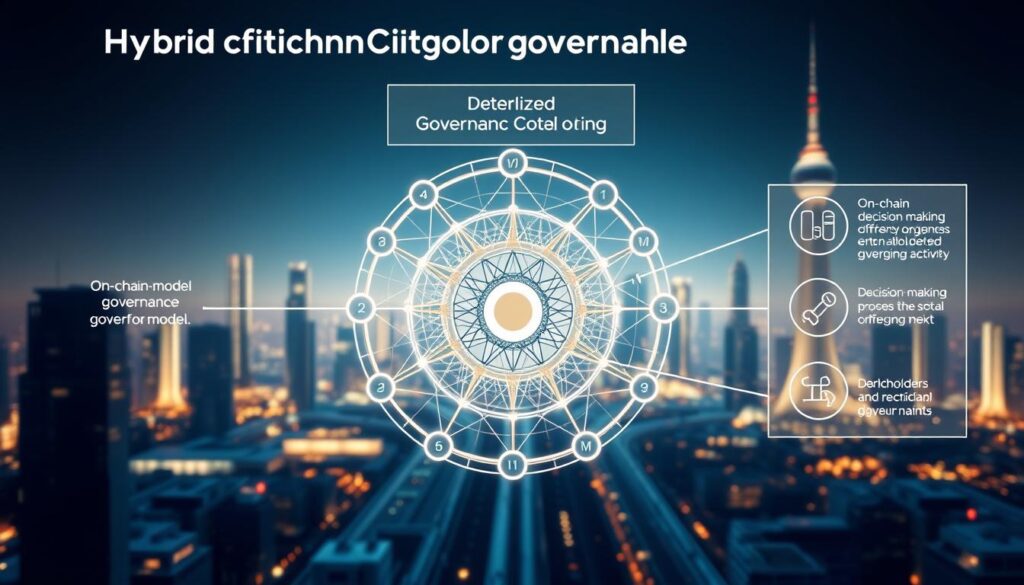Now Reading: Blockchain Governance Models Comparison: Key Features
- 01
Blockchain Governance Models Comparison: Key Features
Blockchain Governance Models Comparison: Key Features

Decentralized networks require clear rules to function effectively. This system of rules and processes is what guides decision-making for these digital platforms.
As this technology matures, having a solid framework becomes crucial. It ensures the network’s security, integrity, and long-term health. These frameworks handle vital activities like protocol updates and resolving disagreements.
Different platforms adopt distinct approaches to their operational rules. Some decisions happen through formal voting on the network itself. Others occur through community discussions away from the core protocol.
Understanding these different systems is key for anyone involved. Developers, enterprises, and users all benefit from knowing how a platform manages change. The right framework supports evolution and maintains trust among all participants.
Key Takeaways
- Governance provides the essential rules and processes for decision-making in decentralized systems.
- Effective frameworks are critical for a network’s security, sustainability, and ability to adapt.
- Key activities include managing protocol upgrades and facilitating stakeholder engagement.
- Approaches vary significantly, primarily falling into on-chain and off-chain categories.
- The chosen model directly impacts how a platform evolves and responds to community needs.
- Evaluating different systems helps users and developers select platforms that align with their goals.
Introduction to Blockchain Governance
The foundation of any successful distributed network lies in its ability to coordinate change. This coordination system determines how platforms evolve and maintain stability.
What is Blockchain Governance?
This framework encompasses the rules that guide decision-making processes. It includes mechanisms for validating transactions and implementing protocol upgrades.
Stakeholders like developers and users participate through defined processes. These systems ensure fairness and transparency when resolving conflicts.
The table below shows core components of this operational framework:
| Component | Primary Function | Key Examples |
|---|---|---|
| Consensus Mechanisms | Validate transactions and maintain network state | Proof of Work, Proof of Stake |
| Protocol Upgrades | Implement improvements and new features | Community voting, developer proposals |
| Stakeholder Participation | Include diverse voices in decisions | User voting, miner influence |
| Dispute Resolution | Address conflicts fairly | Transparent arbitration processes |
Importance of Effective Governance
Proper frameworks establish clear procedures for addressing security vulnerabilities. They create mechanisms for necessary updates without causing disruptions.
Transparent decision-making processes foster community trust among participants. Effective systems directly impact a platform’s ability to survive and thrive.
As networks grow, coordination challenges become more complex. The right framework balances efficiency with thorough community consultation.
Understanding Governance Frameworks in Blockchain
Governance frameworks serve as the constitutional blueprint for how a platform evolves and resolves conflicts. They provide the necessary structure for collective action when no single entity is in charge.
These structures are built from several core components. Key elements include formal decision-making mechanisms and systems for identifying and engaging stakeholders.
A comprehensive framework also outlines proposal submission and review processes. It defines voting or consensus-building methods and procedures for implementing approved changes.
This architectural plan must operate across multiple layers. It handles technical protocol decisions, economic policy influencing incentives, and social coordination to maintain community cohesion.
Effective designs carefully balance competing priorities. They weigh speed against deliberation and expertise against inclusivity. Different frameworks make distinct trade-offs based on their core philosophy.
These systems exist on a wide spectrum. On one end are highly formalized, on-chain processes with automated execution. On the other are informal, off-chain approaches relying on social consensus.
The right framework depends heavily on the network’s specific context. Factors like size, stakeholder diversity, and technical complexity all influence the ideal design. This foundational knowledge prepares you to evaluate different systems effectively.
Evolution of Governance Models
Early digital ledger systems operated with minimal formal decision-making structures. They relied instead on community consensus and informal discussions.
This approach worked initially but faced challenges as networks grew. Contentious debates revealed the limitations of purely informal coordination.
Historical Perspectives and Technological Shifts
Bitcoin established the first operational framework through developer consensus and miner signaling. Major protocol decisions emerged from community forums rather than formal voting.
The block size debate demonstrated the need for more structured processes. This led to network forks and prompted innovation in coordination design.
Newer platforms introduced formal voting mechanisms embedded directly in protocols. Systems like Tezos allowed stakeholders to vote on changes with automatic implementation.
Ethereum developed hybrid approaches combining community discussions with formal processes. Improvement proposals evolved into more structured decision-making systems.
| Time Period | Primary Approach | Key Characteristics | Representative Platforms |
|---|---|---|---|
| 2009-2015 | Informal Coordination | Community forums, developer consensus | Bitcoin |
| 2015-2020 | Formal On-Chain Systems | Embedded voting, automated execution | Tezos, Decred |
| 2020-Present | Hybrid Frameworks | Combined off-chain discussion with on-chain voting | Ethereum, newer protocols |
Technological advances enabled more sophisticated coordination methods. Smart contracts and improved voting systems expanded possibilities for decentralized decision-making.
Each generation learns from previous successes and failures. The evolution continues toward frameworks that better balance competing demands.
On-Chain Governance: Mechanisms and Core Principles
The on-chain approach transforms decision-making from an external process to an integral component of the network’s core functionality. This system embeds voting mechanisms directly into the protocol using smart contracts.
All activities become automated and permanently recorded on the distributed ledger. This creates a transparent environment where every participant can verify the entire process.
Direct Participation and Transparency
Token holders gain direct voting rights through this system. They can submit proposals and cast votes that are immediately recorded.
The permanent nature of these records ensures complete visibility. Anyone can audit the decision-making process at any time.
Incentives and Immutable Records
Networks often incorporate reward systems to encourage active involvement. These incentives help maintain high participation rates among stakeholders.
Once recorded, decisions cannot be altered or removed. This immutability provides strong accountability for all governance actions.
| Feature | Mechanism | Transparency Level | Implementation |
|---|---|---|---|
| Voting System | Token-based weighting | Fully visible | Smart contract automation |
| Proposal Process | Stakeholder submission | Public verification | On-chain recording |
| Incentive Structure | Participation rewards | Transparent allocation | Protocol-integrated |
| Decision Execution | Automatic implementation | Audit trail available | Immediate activation |
Off-Chain Governance: Flexibility and Challenges
When decision-making occurs beyond the primary ledger, it creates a flexible but complex governance environment. This approach relies on external coordination rather than built-in protocol mechanisms.
Off-chain systems enable nuanced discussions that consider multiple perspectives. They allow for rapid adaptation to changing circumstances without technical constraints.
Community Discussions and Proposal Processes
These frameworks typically operate through multiple communication channels. Technical proposals often begin on platforms like GitHub where developers collaborate.
Community forums host broader debates about protocol changes. Developer calls coordinate implementation details across teams.
Social media channels capture community sentiment and emerging concerns. This multi-layered dialogue informs final decisions through informal consensus.
Limitations and Centralization Risks
Despite their flexibility, off-chain systems face significant transparency challenges. Discussions occur across fragmented platforms without automatic recording.
Measuring true community consensus becomes difficult without formal voting mechanisms. Influential participants may dominate conversations, creating centralization risks.
This approach can lead to contentious outcomes when factions cannot reach agreement. The lack of binding mechanisms sometimes results in network splits.
Hybrid Governance Models: Balancing On-Chain and Off-Chain Approaches
Some digital platforms avoid choosing between on-chain and off-chain methods by implementing a hybrid system. This approach strategically combines elements from both frameworks to create more effective decision-making processes.

Hybrid systems typically operate in layers. Off-chain discussions allow for detailed technical analysis and community debate. These conversations then inform formal on-chain voting that creates binding decisions.
This layered approach addresses weaknesses in pure systems. It captures nuanced discussions that simple votes cannot express. Simultaneously, it maintains transparency through recorded on-chain outcomes.
Ethereum demonstrates this balanced approach effectively. The platform uses Ethereum Improvement Proposals for technical discussions. Meanwhile, on-chain mechanisms handle certain decisions, especially after moving to proof-of-stake.
Different stakeholders receive distinct roles in these frameworks. Developers typically propose changes through off-chain processes. Token holders then exercise final approval authority through recorded votes.
These systems can adapt their balance based on decision types. Protocol-level changes often use formal on-chain voting. Operational matters might rely on faster off-chain coordination.
Hybrid frameworks face complexity challenges that require careful design. Clear communication helps participants understand different mechanisms. Despite these challenges, the approach offers significant advantages for evolving platforms.
blockchain governance models comparison
The landscape of distributed systems reveals diverse methodologies for managing protocol changes and stakeholder input. Leading platforms demonstrate distinct operational frameworks that shape their evolution.
Bitcoin employs an informal system where decisions emerge through developer consensus and miner signaling. This approach prioritizes decentralization but can require extended deliberation periods.
Tezos utilizes formal on-chain voting where token holders directly approve protocol amendments. This structured process enables faster upgrades through automated implementation.
Ethereum combines extensive off-chain discussion with increasingly formal on-chain mechanisms. The hybrid framework balances community input with binding decision pathways.
Cardano implements a treasury system allowing community members to propose and vote on projects. This structured approach enhances participatory input across diverse stakeholders.
| Platform | Approach | Decision Speed | Participation Level |
|---|---|---|---|
| Bitcoin | Informal Off-Chain | Slower Consensus | Technical Community Focus |
| Ethereum | Hybrid Framework | Balanced Pace | Broad Community Input |
| Tezos | Formal On-Chain | Rapid Implementation | Token Holder Voting |
| Cardano | Structured Treasury | Methodical Process | Multi-Stakeholder Participation |
Each system reflects underlying platform philosophies about change management. No single approach proves universally superior across all contexts. The choice involves trade-offs between speed, inclusivity, and security requirements.
Understanding these differences helps participants select platforms aligned with their priorities. The right framework depends on specific needs for adaptation and community involvement.
Token-Based Voting in Blockchain Governance
Token-weighted voting systems establish direct correlation between financial investment and decision-making power. This approach allows stakeholders to influence platform evolution based on their economic stake.

Networks implementing this method typically grant one vote per token held. This creates proportional influence where larger holders have greater say in important decisions.
Voting Power and Delegation Mechanisms
Delegation features address participation challenges for less engaged stakeholders. Token holders can assign their voting rights to trusted representatives.
Platforms like Tezos and Polkadot offer sophisticated delegation systems. These include liquid democracy where assignments can change dynamically.
Some networks incorporate time-locked voting for committed participants. Longer commitment periods may receive weighted influence in certain decisions.
Challenges of Token Concentration
Wealth concentration creates significant concerns for decentralized systems. When few entities control large token percentages, they dominate voting outcomes.
Real-world data shows highly unequal token distribution across most networks. This raises questions about true decentralization in decision-making processes.
Some platforms implement mitigation strategies like quadratic voting. This reduces marginal influence of additional tokens to address power concentration.
The Role of Smart Contracts in Governance Processes
Automated execution lies at the heart of modern decentralized decision-making systems. Smart contracts transform how rules are applied by encoding them directly into executable code.
These digital agreements run autonomously, removing the need for manual intervention. They ensure that every step follows predetermined rules without exception.
Automating Proposal Implementation
Once stakeholders approve a change, smart contracts trigger immediate action. This automation covers everything from simple fee adjustments to complex protocol upgrades.
The system works by checking if voting thresholds are met. When conditions are satisfied, the contract executes the change automatically.
This process eliminates delays caused by human coordination. It also prevents errors that can occur during manual implementation.
Trust becomes built into the system rather than relying on individuals. Anyone can verify that the rules were followed correctly because everything is recorded transparently.
However, this automation comes with important considerations. Code immutability means fixing errors requires careful planning. Technical complexity can also create barriers for non-programmers.
Despite these challenges, the efficiency gains are significant. Platforms using this approach can adapt faster to community needs while maintaining strong accountability.
Consortium Governance Frameworks for Enterprises
Business alliances using distributed ledger technology require special coordination systems. Multiple organizations working together need clear rules for decision-making and conflict resolution.

These collaborative frameworks define member roles and voting procedures. They handle technical upgrades and business matters through formal processes.
Legal and Regulatory Considerations
Enterprise partnerships must follow strict legal requirements. Data privacy rules like GDPR affect how information is shared between organizations.
Financial regulations govern transactions and asset handling. Intellectual property rights protect shared technology development among stakeholders.
Groups like the Global Legal Blockchain Consortium create standards for compliance. Their work helps organizations navigate complex legal landscapes.
Successful Enterprise Case Studies
The Enterprise Ethereum Alliance shows how large groups can coordinate effectively. Their framework balances technical needs with business realities.
Hyperledger’s approach demonstrates successful multi-organization collaboration. They establish clear procedures for managing shared platform evolution.
R3’s Corda Network maintains regulatory compliance across jurisdictions. Their governance structure resolves disputes while encouraging innovation.
Decentralized Autonomous Organizations (DAOs) and Governance Innovation
Decentralized autonomous organizations (DAOs) are reshaping how groups make collective decisions by embedding organizational rules directly into code. These entities operate through smart contracts, automating processes like voting and fund allocation.
DAOs represent a fundamental shift from traditional hierarchies. Members collectively steer the organization based on predefined, transparent rules.
Platforms like Aragon and DAOstack provide the tools to build these organizations. They offer modular frameworks for creating custom voting systems and managing treasuries.
This environment fosters significant innovation in decision-making. New methods like quadratic voting help balance influence among stakeholders.
Reputation-based systems can also recognize non-financial contributions. These approaches create more inclusive and equitable structures.
Enterprises are exploring DAOs for consortium projects. They enable transparent resource allocation and coordinated development efforts across multiple companies.
DAOs serve as experimental labs for new organizational forms. From managing investment funds to governing digital platforms, they demonstrate practical applications.
| DAO Type | Primary Function | Key Innovation | Example |
|---|---|---|---|
| Protocol DAO | Governs decentralized applications | On-chain proposal voting | Uniswap |
| Investment DAO | Collective asset management | Community-driven portfolio decisions | MetaCartel Ventures |
| Social DAO | Coordinates community activities | Reputation-based contribution rewards | Friends With Benefits |
Despite their potential, DAOs face real challenges. Encoding complex human decisions into smart contracts is difficult.
Legal status and member liability remain uncertain in many regions. Security is also a paramount concern for these code-driven entities.
Multi-Stakeholder Governance Committees for Collaborative Decision-Making
Enterprise consortia frequently create specialized groups for strategic oversight. These committees bring together representatives from member organizations to guide collective direction.

These bodies typically include diverse voices. Core developers, major token holders, active users, and subject matter experts all contribute perspectives.
Ensuring Inclusivity and Accountability
Formal mechanisms prevent any single group from dominating discussions. This creates essential checks and balances within the decision-making processes.
Real-world examples demonstrate this approach effectively. The R3 consortium’s governance committee and Corda Network’s governing body show successful implementation.
These structures require careful design to function properly. Representation methods, voting procedures, and term limits must be clearly defined.
| Committee Feature | Implementation Method | Primary Benefit |
|---|---|---|
| Representation Balance | Seats allocated to stakeholder categories | Prevents dominance by any single group |
| Decision Thresholds | Super-majority or multi-group consensus required | Ensures broad agreement on important matters |
| Transparency Measures | Public deliberation records and regular reporting | Maintains accountability to broader community |
| Member Selection | Formal nomination and approval processes | Ensures qualified, representative participants |
Accountability mechanisms include recall procedures and community input channels. These ensure committee members remain responsive to stakeholder needs.
Despite their benefits, these committees face coordination challenges. Balancing efficiency with thorough consultation requires ongoing attention.
Enhancing Transparency and Trust in Blockchain Governance
Clear visibility creates unprecedented opportunities for building confidence in distributed systems. This approach moves beyond traditional trust models that rely on institutional reputation.
Modern platforms leverage inherent capabilities to create auditable records. Stakeholders gain mathematical certainty about decision-making processes.
Blockchain as an Immutable Ledger
The technology’s core characteristics make it ideal for governance infrastructure. All activities recorded on-chain become permanent and tamper-proof.
Anyone can independently verify these records without trusting intermediaries. This creates strong accountability through cryptographic proofs rather than administrative promises.
Platforms like Ethereum demonstrate these benefits effectively. Their public ledgers allow complete audit trails of governance history.
Transparent Voting Mechanisms
On-chain voting systems provide complete visibility into decision processes. Every vote is publicly recorded with cryptographic validation.
Participants can verify that tallies are accurate and changes match approved proposals. This builds trust among diverse stakeholders who lack personal relationships.
Transparent mechanisms also help detect malicious behavior early. The system enables cooperation where traditional trust relationships don’t exist.
Best Practices and Case Studies in Blockchain Governance
The most resilient coordination systems emerge from analyzing both successful implementations and notable failures. Real-world examples provide concrete guidance for establishing effective operational frameworks.
Lessons from Leading Platforms
Major networks offer valuable insights into successful coordination methods. Ethereum’s hybrid approach demonstrates balanced community input with formal processes.
Tezos shows how automated voting enables seamless protocol upgrades. Cardano’s structured participation ensures diverse stakeholder voices are heard.
These examples highlight essential best practices. Clear documentation and transparent communication channels prove critical for success.
Adapting to Regulatory Demands
Modern frameworks must navigate complex legal environments while maintaining core principles. Compliance mechanisms should satisfy requirements without compromising decentralization.
Enterprise consortia like R3 demonstrate effective balance between business needs and regulatory compliance. Proactive engagement with authorities helps shape sensible standards.
Regular evaluation ensures frameworks remain effective as conditions evolve. This adaptive approach supports long-term sustainability.
Future Trends and Innovations in Governance Models
Next-generation protocols are introducing groundbreaking methods for collective decision-making. These innovations address longstanding challenges in distributed systems.
Emerging Technologies and Next-Generation Protocols
Advanced cryptographic techniques enable new possibilities for secure voting. Zero-knowledge proofs allow private participation while maintaining verifiability.
Artificial intelligence analyzes proposal data to predict outcomes. Machine learning optimizes delegation systems based on preference alignment.
Cross-chain coordination frameworks manage interconnected ecosystems. They align interests across diverse communities with different operational rules.
| Innovation Area | Technology | Primary Benefit | Implementation Status |
|---|---|---|---|
| Private Voting | Zero-Knowledge Proofs | Privacy with verifiability | Experimental phase |
| Influence Balancing | Quadratic Voting | Reduces plutocratic tendencies | Limited deployment |
| Cross-Network Coordination | Interoperability Protocols | Multi-chain decision alignment | Early development |
| Automated Optimization | Machine Learning | Data-driven policy adjustments | Research stage |
Scalability solutions require specialized management approaches. Layer-2 systems and sharding architectures need tailored coordination mechanisms.
These advancements represent significant steps toward more inclusive frameworks. They combine technical innovation with deeper understanding of human coordination.
Conclusion
As we’ve explored, no single approach to managing distributed networks stands above all others. Each system offers distinct advantages that suit different contexts and priorities.
The most effective frameworks balance competing needs like speed versus deliberation. They adapt to specific stakeholder interests and technical requirements. Context determines which coordination method works best.
Successful platforms evolve their decision-making processes over time. They learn from experience and incorporate new innovations. This ongoing refinement ensures networks remain responsive to changing conditions.
Looking ahead, continued experimentation will yield more sophisticated systems. These advancements promise better alignment of participant interests with network outcomes.
FAQ
What is the main difference between on-chain and off-chain governance?
On-chain governance uses the network’s protocol for decision-making, like token-based voting. Changes are automated through smart contracts. Off-chain governance relies on discussions and decisions made outside the system, such as community forums. This method offers flexibility but can be slower and less transparent.
How do Decentralized Autonomous Organizations (DAOs) handle voting?
DAOs typically use token-based voting mechanisms. Each token often represents one vote. Members can also delegate their voting power to others. This system aims for decentralized control, but large token holders can have significant influence.
What are the risks of token concentration in voting systems?
When a few participants hold a large number of tokens, it can lead to centralization of power. This concentration can undermine the decentralized nature of a network. It may also allow major stakeholders to sway decisions in their favor, potentially harming the broader community’s interests.
Can you give an example of a hybrid governance model?
A hybrid model combines on-chain and off-chain elements. For instance, a platform might use off-chain forums for initial proposal discussions. Then, it could move to an on-chain vote for final approval and automated implementation. This approach seeks to balance community input with efficient execution.
Why is transparency important for trust in these systems?
Transparency ensures all actions and decisions are visible and verifiable by participants. When voting records and transactions are immutable and public, it builds confidence in the process. This openness helps hold decision-makers accountable and fosters greater trust in the network’s integrity.
How do smart contracts automate governance processes?
Smart contracts execute predefined rules automatically when certain conditions are met. For example, if a governance proposal receives enough votes, a smart contract can instantly implement the change. This automation reduces the need for manual intervention and increases the speed and reliability of decision implementation.














